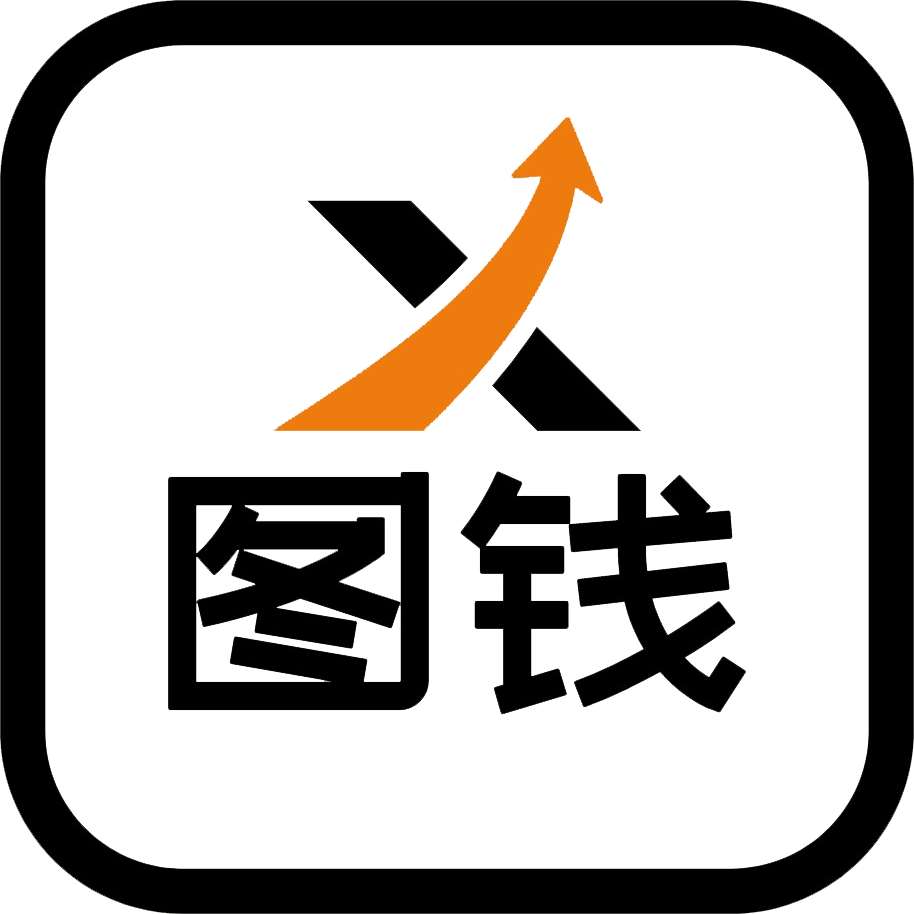Maritime Beyond Visual Range Wireless Transmission Solution
I. Core Requirements and Challenges
The rapid development of industries such as maritime transportation, fishery farming, and deep-sea energy exploration has imposed strict requirements on long-distance communication. These scenarios not only need stable transmission of voice and data, but also support services like high-definition video surveillance and real-time data transmission back. The core lies in breaking through the line-of-sight limitations caused by the curvature of the earth, while also coping with multiple disturbances from the marine environment.
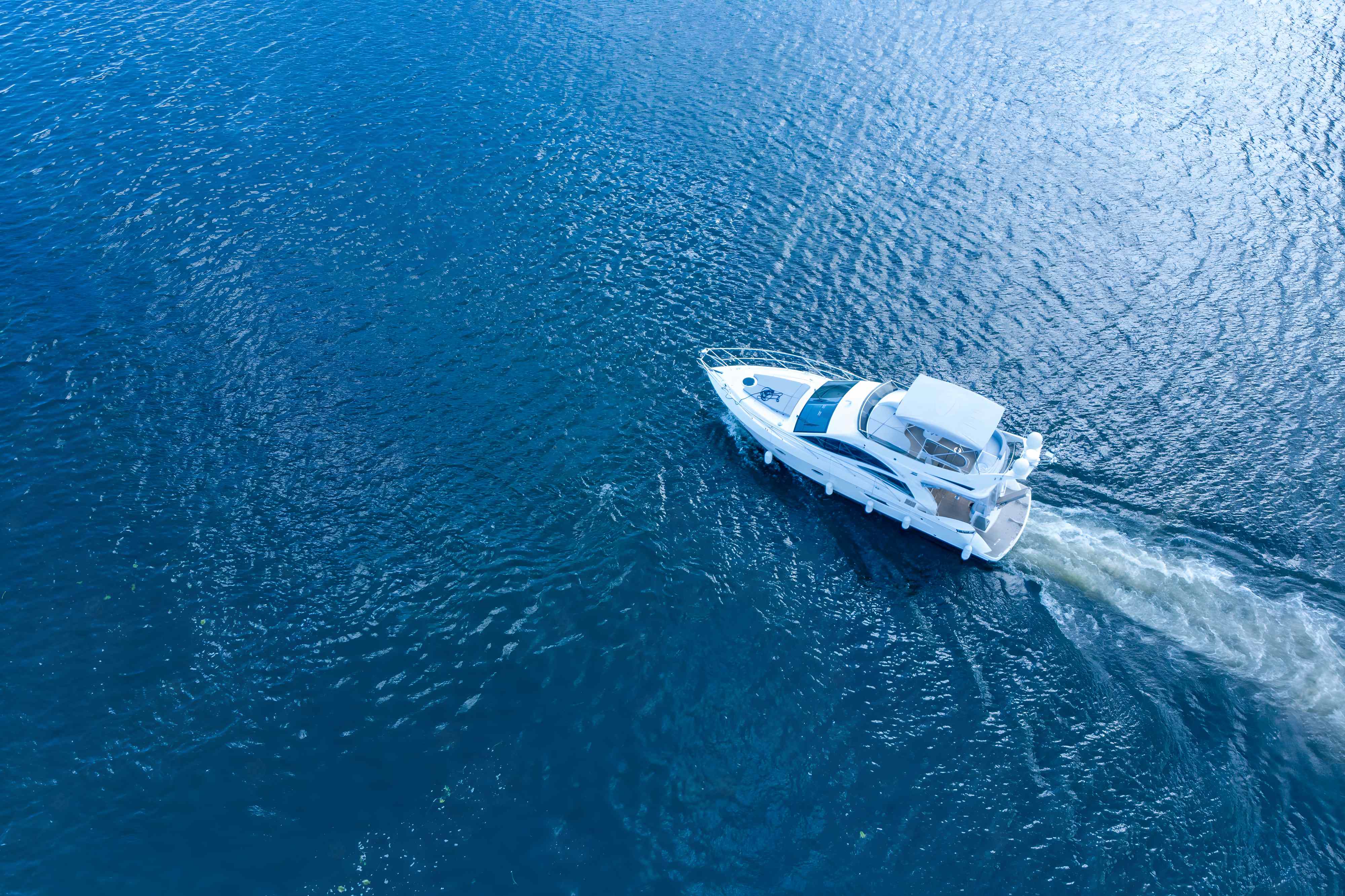
The main challenges currently faced are:
● Signal attenuation is severe: The absorption and scattering of electromagnetic waves by seawater are significant. Coupled with meteorological factors such as wind waves, fog, and rainfall, the signal will rapidly weaken, especially in the high-frequency range.
● The equipment must have high adaptability to the environment: Severe humidity, strong salt fog, significant temperature fluctuations, and ship vibrations in the maritime environment require the equipment to have a protection level of IP66 or above, and be able to withstand temperature fluctuations ranging from -40℃ to 70℃.
● Cost coverage and scalability issues: Traditional shore-based base stations have limited coverage (typically 30-50 kilometers), while building a large number of offshore base stations is costly; moreover, as the number of offshore operation vessels increases, the network needs to have the flexibility for scalable expansion.
II. Mainstream Technical Solutions
(1) Microwave Communication Scheme
● Technical principle: Utilizing the linear propagation characteristics of electromagnetic waves in the Ku band (12-18GHz) and the Ka band (26.5-40GHz), the signal is focused and transmitted through high-gain directional antennas. When the transmission distance exceeds the single-hop line-of-sight (typically 50-100 kilometers), relay stations are deployed on islands or offshore platforms to form a multi-hop link of "shore-based - relay - onboard", achieving over-the-horizon coverage.
● Core Advantage:
1. The bandwidth is sufficient, with the single-link rate capable of reaching 100Mbps to 1Gbps, which can meet the real-time transmission requirements of 4K high-definition videos.
2. It is less affected by ionospheric fluctuations and has better signal stability than high-frequency (HF) communication. The bit error rate can be controlled below 10⁻⁶.
● Equipment Configuration:
1. The power of the transmitter is usually between 5 and 20 watts. For example, a certain maritime-specific model has a transmission power of 15 watts, combined with a parabolic antenna with a gain of 30 dB, the single-hop transmission distance can reach up to 80 kilometers.
2. The receiver sensitivity should be below -105dBm. For some high-end devices, it can be as low as -110dBm, which is capable of effectively capturing weak signals.
3. The relay station adopts an integrated design, integrating signal amplification and frequency conversion modules, and supports automatic gain control, enabling it to adapt to changes in link attenuation.
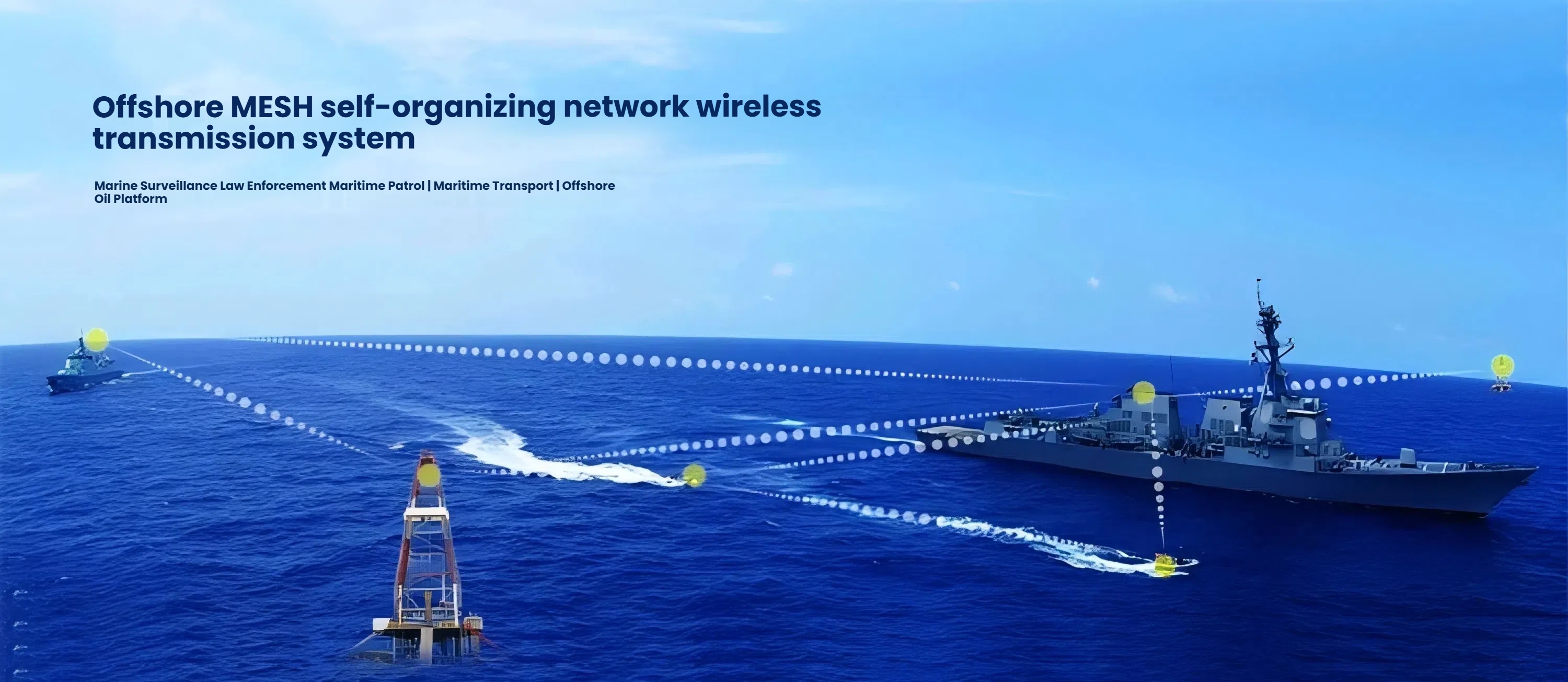
(2) MESH Self-Organizing Network Solution
● Technical Principle: A mesh topology is formed by multiple MESH nodes on ships or platforms. Nodes are dynamically connected via wireless links. Each node acts both as a terminal and a relay. A distributed routing protocol (such as AODV, OLSR) is adopted, enabling real-time perception of network topology changes and automatic selection of the optimal transmission path. In the event of a node failure or when it moves away, the network can reconfigure the links within a few hundred milliseconds, ensuring continuous communication.
● Core Advantage:
1. Highly resilient, without relying on a central node, suitable for dynamic scenarios such as fishing vessel clusters and offshore operation fleets.
2. Supports multi-service integration. A single node can simultaneously handle 8 1080P video streams, dozens of voice calls, and a large amount of sensor data, with a total bandwidth of 50-200 Mbps.
● Equipment Configuration:
1. The onboard MESH terminal is equipped with a sealed metal casing and has a protection level of IP67, which can resist salt fog corrosion and short-term immersion in water. The transmission power is 3-10W. When paired with an 8dB omnidirectional fiberglass antenna, the coverage radius of a single node is approximately 5-15 kilometers; if a 20dB directional antenna is used, the point-to-point transmission distance can extend up to 30 kilometers.
2. The system software is equipped with a bandwidth allocation function, which can prioritize the guarantee of critical services such as command voice and emergency data, with the delay controlled within 100ms.
(3) Satellite Communication Support Scheme
● Technical positioning: As a supplement to terrestrial communication, it is mainly designed to address the coverage gaps in remote and distant sea areas.
● Characteristics of the mainstream system:
1. Maritime satellites (such as Inmarsat Fleet Xpress): They achieve global coverage through geostationary satellites, with a downlink speed of 50 Mbps and an uplink speed of 10 Mbps. They support the Global Maritime Distress and Safety System (GMDSS), but the bandwidth cost is relatively high. They are suitable for critical business backup.
2. Low Earth Orbit Satellites (such as Starlink Maritime): Comprising a constellation of satellites in low Earth orbit, the latency is as low as 20-50ms, the downlink rate is 100-350Mbps, capable of supporting real-time services such as high-definition video conferences. However, the terminal equipment is relatively large (with an antenna diameter of approximately 0.4-1.2 meters), and it is subject to the satellite overhead time limit.
● Integration mechanism: Through intelligent switching gateways, when the vessel enters the coverage area of the ground microwave or MESH network (signal strength ≥ -85dBm), it automatically switches to the ground link; if it exceeds the range, it seamlessly switches to satellite communication. The interruption time during the switching process is less than 1 second, ensuring that the service is not interrupted.
III. Key Points for Equipment Deployment
(1) Shore-based equipment
● The site selection for the base station should give priority to coastal highlands, lighthouses or dedicated communication towers. Ensure that the antenna height is ≥ 30 meters. If deployed on the top of a mountain at an altitude of 50 meters, combined with a 65-degree sector antenna with a 25dB gain, it can cover an area of 80 kilometers of the sea.
● The base station should be equipped with dual power backup (utility power + solar power), and a lightning protection and grounding system should be installed (grounding resistance < 4Ω) to prevent damage to equipment caused by lightning strikes.
● The core base station can be connected to the optical fiber backbone network, with a bandwidth of ≥ 1 Gbps, which can meet the requirements for multi-link data transmission and return.
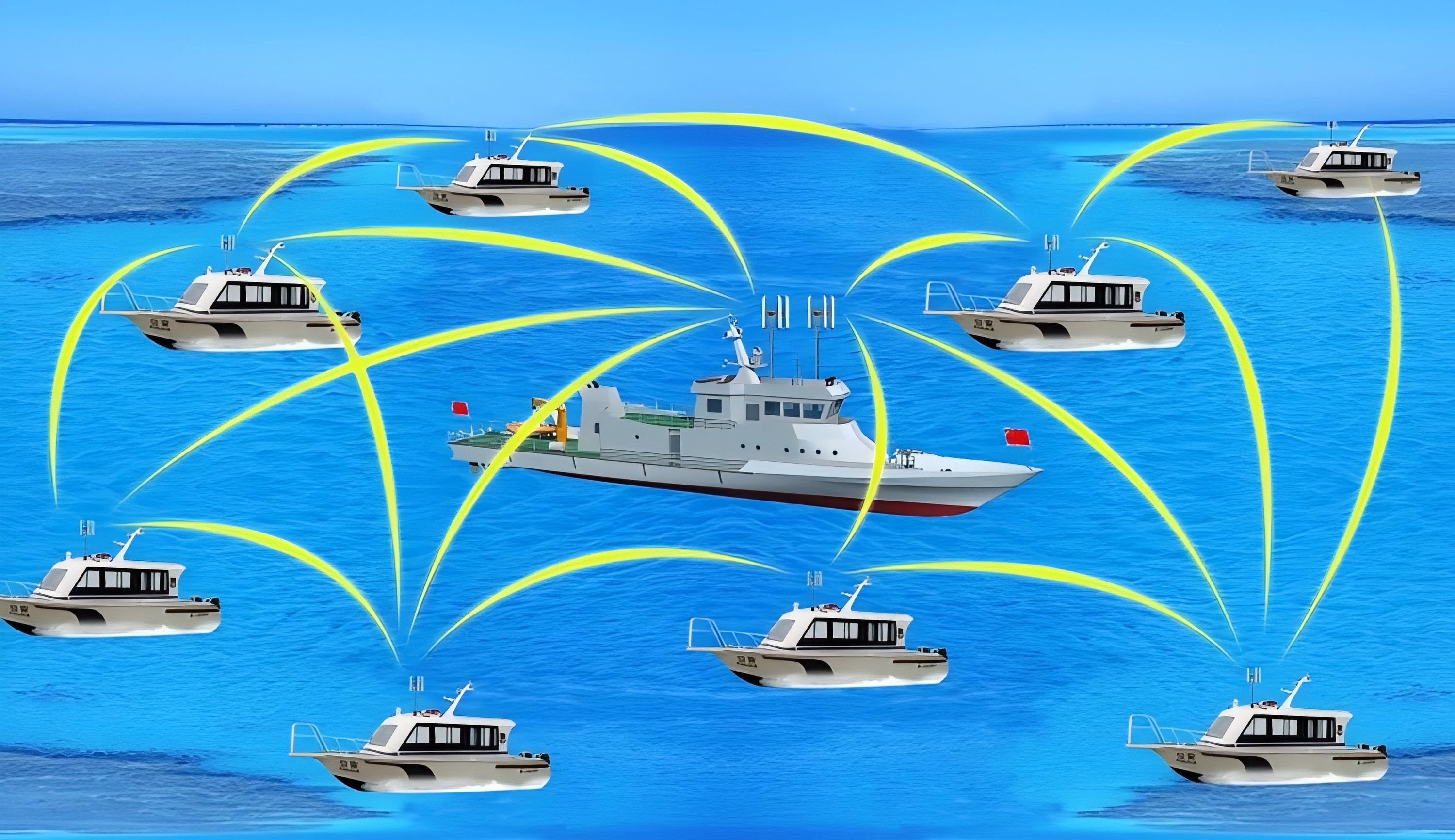
(2) Shipborne Equipment
● The terminal is installed on the top of the ship in an unobstructed area. The antenna height is ≥ 6 meters. For large fishing vessels, it can be installed on the top of the mast. Omnidirectional antennas need to be 360 degrees unobstructed, while directional antennas need to be linked with GPS and electronic compass to automatically align with the direction of the shore base or relay station.
● The equipment must be fixed on the shock-absorbing support, capable of withstanding a tilt of ±15 degrees and an impact of ±20G, ensuring stable operation in harsh sea conditions.
● Small fishing boats can be equipped with portable terminals, weighing less than 5 kilograms, with battery life of at least 8 hours, meeting the temporary communication requirements.
(3) Relay Deployment
● Deploy microwave relay stations on islands or offshore platforms that are 50 to 100 kilometers away. Adopt a dual-link design (primary and backup links). In the event of a disruption of the primary link, switch to the backup link within 0.5 seconds.
● The repeater antenna should be equipped with rain attenuation compensation function. In rainy weather, it can automatically increase the transmission power by 2-3 dB to counteract the signal attenuation.
IV. Scheme Advantages
● Balanced coverage capability: Within 50 kilometers of the shore, it relies on microwave and MESH networking; from 50 to 300 kilometers, it expands through relay stations; beyond 300 kilometers, it is supplemented by satellites, achieving seamless coverage of the entire sea area.
● Reliability Assurance: The equipment is resistant to salt fog and vibration. The network adopts a multi-path redundant design, and a single point failure will not affect the overall communication. The annual availability rate is ≥ 99.5%.
● Flexible expansion: MESH nodes can be adjusted according to the number of operation vessels, microwave relay stations can be gradually deployed based on the progress of sea area development, and satellite resources can be paid for on a per-use basis, thereby reducing the initial investment cost.
V. Typical Application Scenarios
● Ocean vessel monitoring: Cargo ships use a combined microwave + satellite link to transmit real-time ship position, engine room status, and cargo monitoring videos to the shore-based command center. This enables remote scheduling and fault diagnosis.
● Offshore Wind Power Operation and Maintenance: The wind farm platform achieves internal communication through MESH networking, and simultaneously uses microwave links to transmit equipment operation data (such as wind speed and power generation) back to the land-based control center. The latency is less than 50ms.
● Fishery cluster management: A network of dozens of fishing vessels is formed as an MESH system, sharing fishing conditions and meteorological data. The shore-based center can use this network to issue fishing ban notifications and dispatch rescue forces. Each cluster can support the connection of 50 to 200 vessels.
(2) MESH Self-Organizing Network Solution
● Technical principle: A mesh topology is formed by multiple MESH nodes on ships or platforms. Nodes are dynamically connected through wireless links. Each node acts both as a terminal and a relay. A distributed routing protocol (such as AODV, OLSR) is adopted, enabling real-time perception of network topology changes and automatic selection of the optimal transmission path. When a node fails or moves away, the network can reconfigure the links within hundreds of milliseconds, ensuring continuous communication.
● Core advantage:
1.Highly resilient, without relying on a central node, suitable for dynamic scenarios such as fishing vessel clusters and offshore operation fleets.
2.Support multi-service integration. A single node can simultaneously handle 8 1080P video streams, dozens of voice calls, and a large amount of sensor data, with a total bandwidth of 50-200 Mbps.
● Equipment furnishment:
1.The onboard MESH terminal is equipped with a sealed metal casing and has a protection level of IP67, which can resist salt fog corrosion and short-term immersion. The transmission power ranges from 3 to 10 watts. When paired with an 8dB omnidirectional fiberglass antenna, the coverage radius of a single node is approximately 5 to 15 kilometers; if a 20dB directional antenna is used, the point-to-point transmission distance can extend up to 30 kilometers.
2.The system software has a bandwidth allocation function, which can prioritize the guarantee of critical services such as command voice and emergency data, with the delay controlled within 100ms.
(3) Satellite Communication Assistance Scheme
● Technical positioning: As a supplement to terrestrial communication, it mainly aims to address the coverage blind spots in remote and distant sea areas.
● Characteristics of the mainstream system:
1.Maritime satellites (such as Inmarsat Fleet Xpress): Achieve global coverage through geostationary satellites, with a downlink speed of 50 Mbps and an uplink speed of 10 Mbps. They support the Global Maritime Distress and Safety System (GMDSS), but the bandwidth cost is relatively high. They are suitable for critical business backup.
2.Low-orbit satellites (such as Starlink maritime version): They form constellations consisting of satellites in low Earth orbit, with latency as low as 20-50ms, downlink rate of 100-350Mbps, capable of supporting real-time services such as high-definition video conferences. However, the terminal equipment is relatively large (antenna diameter approximately 0.4-1.2 meters), and is subject to the limitation of the time when the satellite passes overhead.
● Integration mechanism: Through the intelligent switching gateway, when the vessel enters the coverage area of the ground microwave or MESH network (signal strength ≥ -85dBm), it automatically switches to the ground link; if it exceeds the range, it seamlessly switches to satellite communication. The interruption time during the switching process is less than 1 second, ensuring that the service is not interrupted.
III. Key Points for Equipment Deployment
(1) Shore-based equipment
● The location of the base station should give priority to coastal highlands, lighthouses or dedicated communication towers. Ensure that the antenna height is ≥ 30 meters. If deployed on the top of a mountain at an altitude of 50 meters, combined with a 65-degree sector antenna with a 25dB gain, it can cover an area of 80 kilometers of the sea.
● The base station should be equipped with dual power backup (utility power + solar power), and a lightning protection and grounding system should be installed (grounding resistance < 4Ω) to prevent damage to equipment caused by lightning strikes.
● The core base station can be connected to the optical fiber backbone network, with a bandwidth of ≥ 1 Gbps, meeting the requirements for multi-link data transmission and return.
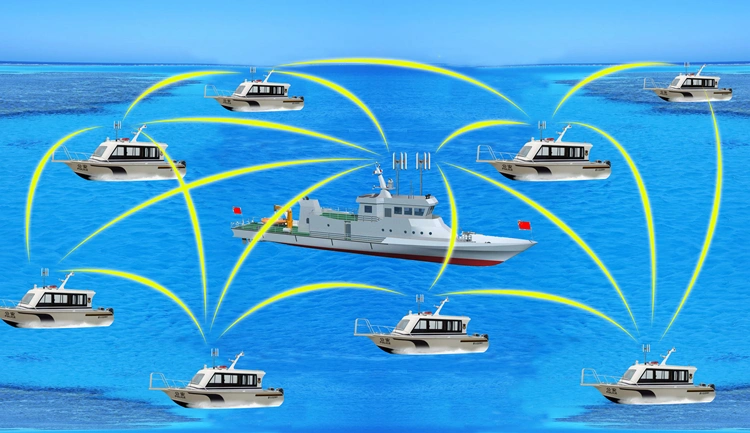
(2) Shipborne Equipment
● The terminal is installed on the top of the ship in an unobstructed area. The antenna height is ≥ 6 meters. For large fishing vessels, it can be installed on the top of the mast. The omnidirectional antenna requires 360-degree unobstructed coverage, while the directional antenna needs to be linked with GPS and electronic compass to automatically align with the direction of the shore base or relay station.
● The equipment must be fixed on the shock-absorbing support, capable of withstanding a tilt of ±15 degrees and an impact of ±20G of the ship, to ensure stable operation under harsh sea conditions.
● Small fishing boats can be equipped with portable terminals, weighing less than 5 kilograms, with battery life of ≥ 8 hours, which can meet temporary communication needs.
(3) Relay Deployment
● Deploy microwave relay stations on islands or offshore platforms that are 50 to 100 kilometers away. Adopt a dual-link design (primary and backup links). In the event of a disruption of the primary link, switch to the backup link within 0.5 seconds.
● The repeater antenna needs to be equipped with rain attenuation compensation function. In rainy weather, it can automatically increase the transmission power by 2-3 dB to counteract the signal attenuation.
IV. Scheme Advantages
● Coverage capability is balanced: within 50 kilometers of the shore, it relies on microwave and MESH networking; from 50 to 300 kilometers, it extends through relay stations; beyond 300 kilometers, it is supplemented by satellites, achieving seamless coverage of the entire sea area.
● Reliability guarantee: The equipment has salt spray resistance and vibration-proof features. The network adopts a multi-path redundant design, and a single point failure will not affect the overall communication. The annual availability rate is ≥ 99.5%.
● Flexible expansion: MESH nodes can be adjusted according to the number of operation vessels. Microwave relay stations can be gradually deployed based on the progress of sea area development. Satellite resources can be used on a pay-per-use basis, reducing the initial investment cost.
V. Typical Application Scenarios
● Ocean-going vessel monitoring: The cargo ship uses a combined link of microwave and satellite to transmit real-time information such as its position, engine room status, and cargo monitoring videos to the shore-based command center. This enables remote scheduling and fault diagnosis.
● Offshore wind power operation and maintenance: The wind farm platform achieves internal communication through MESH networking, and simultaneously uses microwave links to transmit equipment operation data (such as wind speed, power generation) back to the land-based control center, with a latency of less than 50ms.
● Fishery cluster management: A network of dozens of fishing vessels, called MESH, shares fishing conditions and meteorological data. The shore-based center can use this network to issue fishing ban notifications and dispatch rescue forces. Each cluster can support the connection of 50 to 200 vessels.
